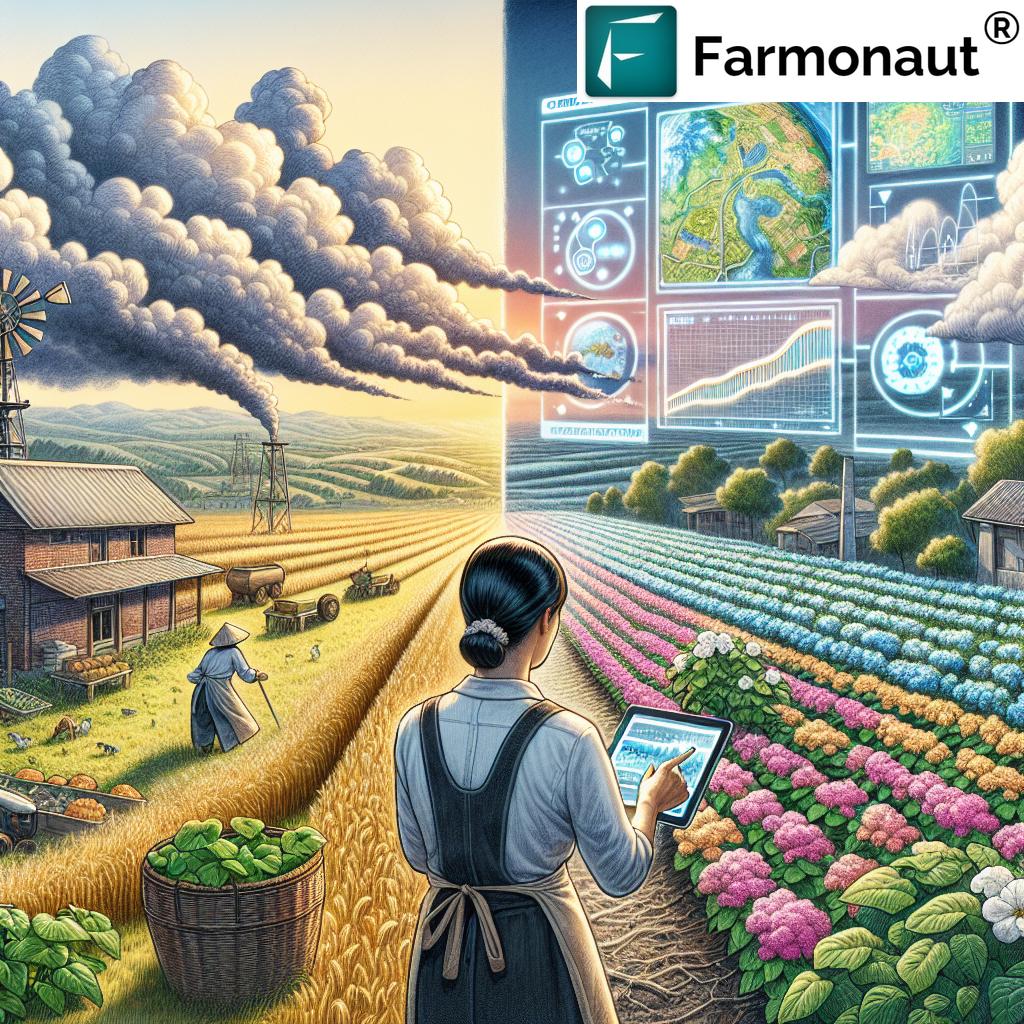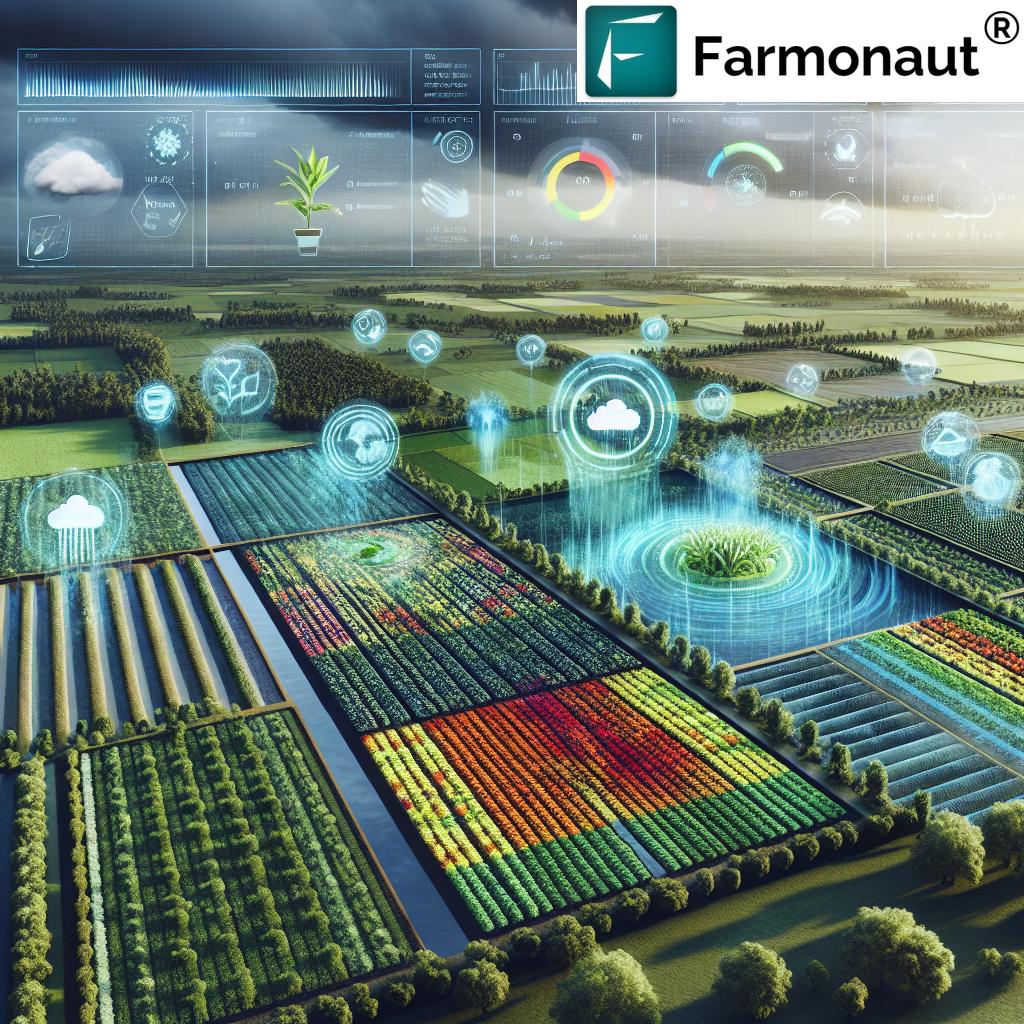Revolutionizing Agriculture: How Climate-Smart Farming and Satellite Technology Boost Sustainability
“Satellite-based precision agriculture can reduce water usage by up to 30% in crop production.”
In the face of global climate change and growing food demand, we find ourselves at a critical juncture in agricultural history. The need for sustainable, efficient, and productive farming practices has never been more urgent. As we delve into the world of climate-smart agriculture, we’ll explore how cutting-edge technologies and innovative approaches are reshaping the agricultural landscape, paving the way for a more sustainable future.
The Dawn of Climate-Smart Agriculture
Climate-smart agriculture (CSA) is a comprehensive approach that addresses the interlinked challenges of food security and climate change. It aims to sustainably increase agricultural productivity, enhance resilience (adaptation), reduce/remove greenhouse gas emissions (mitigation) where possible, and enhance achievement of national food security and development goals.
At the heart of this agricultural revolution are precision agriculture technologies and sustainable farming practices that leverage data, artificial intelligence, and satellite imagery to optimize resource use and boost crop yields while minimizing environmental impact.

Precision Agriculture: The Cornerstone of Climate-Smart Farming
Precision agriculture technologies form the backbone of climate-smart farming. These advanced tools allow farmers to make informed decisions based on real-time data and analytics. Let’s explore some key components:
- Satellite Imagery and Remote Sensing: Satellite-based crop monitoring provides valuable insights into crop health, soil moisture levels, and potential pest infestations. This technology enables farmers to identify issues early and take targeted action, reducing the need for broad-spectrum pesticide applications.
- Agricultural Data Analytics: By processing vast amounts of data from various sources, including satellite imagery, weather stations, and soil sensors, agricultural data analytics platforms offer actionable insights for farm management.
- Smart Farming Solutions: These include IoT devices, drones, and AI-powered systems that work together to automate and optimize various farming processes, from irrigation to harvesting.
One company at the forefront of this technological revolution is Farmonaut. Their platform integrates satellite imagery, AI, and machine learning to provide farmers with real-time crop health monitoring, personalized advisory services, and resource management tools. Farmonaut’s Android app brings these powerful tools directly to farmers’ fingertips.
Sustainable Farming Practices: Nurturing the Earth
While technology plays a crucial role, sustainable farming practices are equally important in climate-smart agriculture. These practices focus on maintaining soil health, conserving water, and promoting biodiversity:
- Conservation Tillage: Minimizing soil disturbance helps retain organic matter and reduce erosion.
- Crop Rotation: Alternating crops helps break pest cycles and improves soil fertility.
- Cover Cropping: Planting cover crops between main crop seasons protects and enriches the soil.
- Integrated Pest Management (IPM): This approach combines biological, cultural, and chemical methods to manage pests effectively while minimizing environmental impact.
These practices, when combined with precision agriculture technologies, create a powerful synergy that drives sustainability in farming.
The Role of Satellite Technology in Modern Agriculture
Satellite technology has emerged as a game-changer in modern agriculture. It provides farmers with a bird’s-eye view of their fields, offering invaluable insights that were previously impossible to obtain. Here’s how satellite technology is transforming farming:
- Crop Health Monitoring: Multispectral satellite imagery can detect changes in plant health before they’re visible to the naked eye, allowing for early intervention.
- Yield Prediction: By analyzing historical and current data, satellite-based systems can provide accurate yield forecasts, helping farmers and markets prepare accordingly.
- Resource Optimization: Satellite data helps identify areas that need more or less water, fertilizer, or other inputs, enabling precise resource allocation.
- Weather Forecasting: Advanced satellite systems provide accurate short-term and long-term weather forecasts, crucial for planning farming activities.
Farmonaut’s platform leverages these capabilities, offering farmers access to high-resolution satellite imagery and AI-powered analysis through their web app.
“Climate-smart farming practices can sequester 0.1 to 1 ton of carbon per hectare annually in agricultural soils.”
Agricultural Emission Reduction: Farming for the Future
Agriculture is both a victim and a contributor to climate change. While farmers grapple with changing weather patterns and extreme events, the sector also accounts for a significant portion of global greenhouse gas emissions. Climate-smart agriculture addresses this dual challenge through various emission reduction strategies:
- Carbon Sequestration: Practices like no-till farming and cover cropping help store carbon in the soil, reducing atmospheric CO2 levels.
- Methane Reduction: In rice cultivation, alternate wetting and drying techniques can significantly reduce methane emissions.
- Efficient Fertilizer Use: Precision application of fertilizers, guided by satellite and soil data, minimizes nitrous oxide emissions.
- Agroforestry: Integrating trees into agricultural landscapes not only sequesters carbon but also provides additional ecosystem services.

Carbon Credits in Agriculture: A New Frontier
As the world seeks to mitigate climate change, carbon credits have emerged as a potential economic incentive for farmers to adopt sustainable practices. Here’s how it works:
- Carbon Sequestration Measurement: Advanced technologies, including satellite imagery and soil sensors, accurately measure the amount of carbon stored in agricultural soils.
- Credit Generation: Farmers earn credits for implementing practices that increase soil carbon or reduce emissions.
- Market Trading: These credits can be sold to companies looking to offset their carbon footprint, creating a new revenue stream for farmers.
Platforms like Farmonaut play a crucial role in this process by providing the necessary data and verification tools. Their API allows for seamless integration of carbon credit tracking into existing farm management systems.
Addressing Global Challenges: Food Security and Climate Resilience
Climate-smart agriculture is not just about sustainability; it’s also a powerful tool for addressing global challenges like food security and climate resilience. Here’s how:
- Increased Productivity: By optimizing resource use and improving crop management, climate-smart practices can significantly boost yields, helping to feed a growing global population.
- Drought Mitigation: Advanced irrigation systems, coupled with drought-resistant crop varieties, help farmers cope with water scarcity.
- Flood Management: Improved drainage systems and land use planning, informed by satellite data, can minimize flood damage to crops.
- Pest and Disease Control: Early warning systems based on satellite imagery and AI can predict and prevent pest outbreaks, reducing crop losses.
Farmonaut’s platform addresses these challenges by providing farmers with tools for risk assessment and management. Their iOS app brings these capabilities to Apple users, ensuring wide accessibility.
The Future of Farming: AI and Machine Learning
As we look to the future, artificial intelligence and machine learning are set to play an even more significant role in agriculture. These technologies promise to:
- Enhance Predictive Analytics: AI models can predict crop yields, pest outbreaks, and market trends with increasing accuracy.
- Automate Farm Operations: From self-driving tractors to robotic harvesters, AI is automating many aspects of farming.
- Personalize Crop Management: Machine learning algorithms can provide tailored recommendations for each field, considering its unique characteristics and history.
- Improve Resource Allocation: AI-powered systems can optimize the use of water, fertilizers, and pesticides, reducing waste and environmental impact.
Farmonaut is at the forefront of this AI revolution in agriculture, continually developing and refining their algorithms to provide farmers with cutting-edge insights and recommendations.
Climate-Smart Agriculture Technologies and Their Benefits
| Technology | Description | Environmental Benefits | Agricultural Benefits |
|---|---|---|---|
| Satellite Imagery | High-resolution images of farmland from space | Reduced chemical use, optimized water management | Early pest detection, improved crop health monitoring |
| Agricultural Data Analytics | Processing and analysis of farm data | Reduced resource waste, lower emissions | Increased yields, better decision-making |
| Smart Farming Solutions | IoT devices and AI-powered systems | Precise resource application, reduced environmental impact | Automated farm operations, increased efficiency |
| Carbon Sequestration Techniques | Methods to store carbon in soil | Reduced atmospheric CO2, improved soil health | Increased soil fertility, potential carbon credits |
| Agroforestry Systems | Integration of trees in agriculture | Enhanced biodiversity, carbon sequestration | Diversified income, improved soil structure |
| Drought Mitigation Technologies | Advanced irrigation and water management | Water conservation, reduced stress on water sources | Improved crop resilience, consistent yields |
| Flood Management Solutions | Improved drainage and land use planning | Reduced soil erosion, preserved water quality | Minimized crop damage, faster recovery post-flood |
| AI-powered Crop Monitoring | Machine learning for crop analysis | Optimized resource use, reduced chemical application | Early problem detection, personalized crop management |
Empowering Farmers: Knowledge and Access
For climate-smart agriculture to reach its full potential, it’s crucial to empower farmers with knowledge and access to these advanced technologies. This involves:
- Education and Training: Providing farmers with the skills to use new technologies and implement sustainable practices.
- Affordable Solutions: Developing cost-effective tools that are accessible to farmers of all scales.
- Policy Support: Implementing policies that incentivize the adoption of climate-smart practices.
- Financial Inclusion: Improving access to credit and insurance for farmers implementing sustainable practices.
Farmonaut contributes to this goal by offering affordable, user-friendly solutions and partnering with financial institutions to improve farmers’ access to credit based on satellite-verified data.
The Road Ahead: Challenges and Opportunities
While the potential of climate-smart agriculture is immense, several challenges remain:
- Data Privacy and Security: As farming becomes more data-driven, ensuring the security and privacy of farmers’ data is crucial.
- Digital Divide: Ensuring that smallholder farmers in developing countries have access to these technologies.
- Standardization: Developing global standards for measuring and verifying sustainable practices.
- Scaling Up: Moving from pilot projects to widespread adoption of climate-smart practices.
However, these challenges also present opportunities for innovation and collaboration. Companies like Farmonaut are working to address these issues, developing scalable solutions that can be adapted to different farming contexts worldwide.
Conclusion: A Sustainable Future for Agriculture
Climate-smart agriculture, powered by satellite technology and data-driven insights, represents a paradigm shift in how we approach farming. By embracing these innovations, we can create a more sustainable, resilient, and productive agricultural sector capable of feeding a growing global population while mitigating climate change.
As we move forward, the collaboration between farmers, technologists, policymakers, and consumers will be crucial in realizing the full potential of climate-smart agriculture. Together, we can cultivate a future where farming is not just a means of production, but a powerful tool for environmental stewardship and global food security.
Platforms like Farmonaut are leading the way in this agricultural revolution, providing farmers with the tools they need to embrace climate-smart practices. By leveraging satellite technology, AI, and data analytics, Farmonaut is helping to create a more sustainable and productive future for agriculture.
For more information on how you can leverage these technologies in your farming practices, explore Farmonaut’s offerings:
Frequently Asked Questions
- What is climate-smart agriculture?
Climate-smart agriculture is an approach that helps guide actions to transform agricultural systems to effectively support development and ensure food security in a changing climate. - How does satellite technology benefit farmers?
Satellite technology provides farmers with real-time data on crop health, soil moisture, and weather patterns, enabling more informed decision-making and efficient resource management. - What are carbon credits in agriculture?
Carbon credits in agriculture are a form of financial incentive for farmers who implement practices that sequester carbon or reduce greenhouse gas emissions. - How does Farmonaut contribute to sustainable farming?
Farmonaut offers a platform that integrates satellite imagery, AI, and machine learning to provide farmers with tools for crop monitoring, resource management, and sustainable farming practices. - What are some examples of climate-smart farming practices?
Examples include conservation tillage, crop rotation, cover cropping, and integrated pest management.






